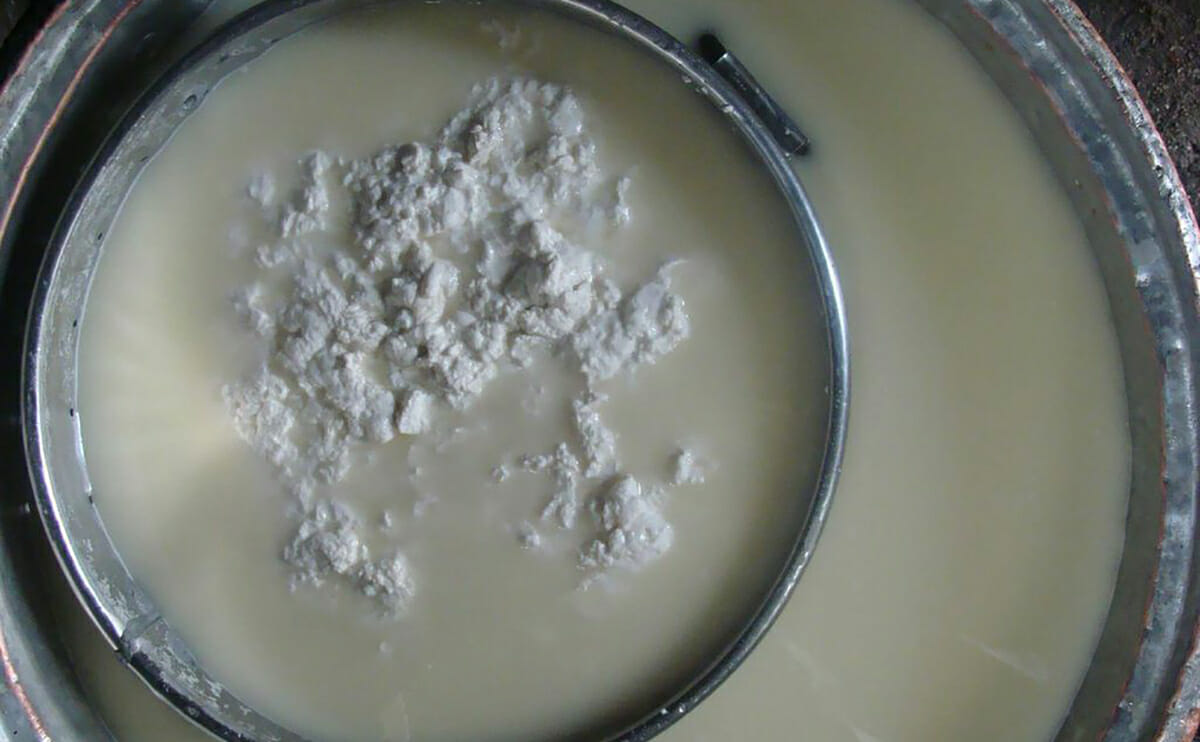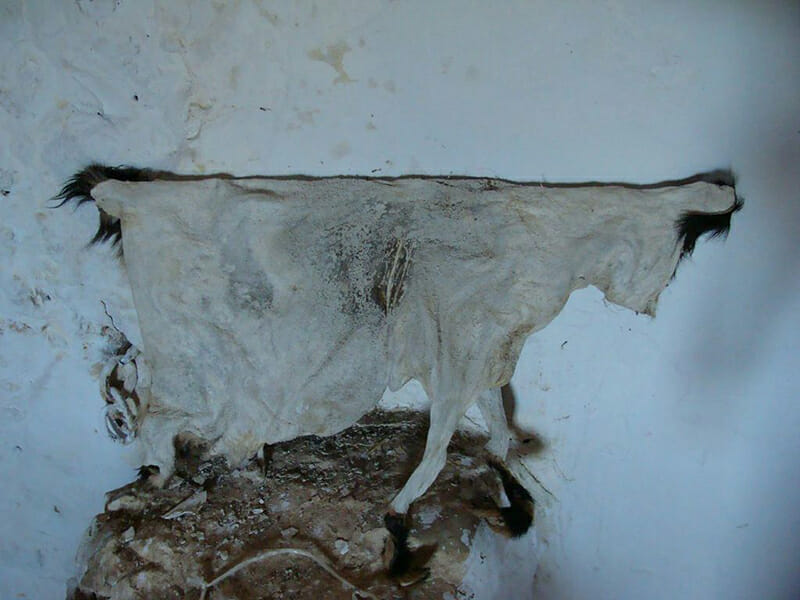One woman's search for an authentic Greek cheese that's aged in the skin of a goat.

Unlike Polyphemus, most shepherds in our region are nomadic, following those ancient monopatia each spring and fall, thus they have had to forgo cave-aging in favor of a more portable solution. Since ancient times, and in other parts of the world, too, that solution has come in the form of the cleaned and heavily salted skin of a goat or a sheep – the perfect vessel for the storage of milk and the aging of cheese.
In Greece, this cheese is commonly called touloumotiri, from touloumi, modern vernacular Greek for the skin of the animal, and tiri, which means “cheese.” Until a few decades ago, it was easy to find touloumotiri in the touloumi throughout Greece. You could purchase it directly from the cheesemaker or at the butcher’s or corner market. Today, many cheesemakers produce a cheese they call touloumotiri, but few use animal skins, forgoing that tradition in favor of wooden or plastic barrels.
Barrel-aged touloumotiri is the cheese I taste most often in the home cooking of my neighbors, and with good reason: Compared to factory-made feta, locally-made touloumotiri is inexpensive. Moreover it is delicious. When fresh, it is soft and moist and has an earthy, creamy flavor. Over time, the cheese dries and hardens, and its flavor sharpens considerably.
But friends have told me that real touloumotiri, the stuff produced in the touloumi, is even better. That a blue mold forms between the cheese and the skin, which the cheesemaker or shopkeeper will, from time to time, knead into the cheese. That the result of this mold is a deliciously pungent and peppery flavor – one that makes your mouth water. After hearing these descriptions over and over again, often told with a certain sense of melancholy and longing, I became curious about touloumotiri produced in the touloumi. Are there any cheesemakers who still produce the real thing, I wondered? If so, why? And, if so, just how do they do it? Finally, I thought to myself, the cheese is made in the skin of an animal? That sounds weird – how can it really be so good?
And so I set off on a hunt for real touloumotiri, but from the beginning the leads were few. “The touloumi left when electricity came to the village,” one cheesemaker told me. “But that was just ten years ago,” I retorted. “Siga, (slow down),” she said, “and have another ouzo.”
But I carried on and eventually I learned through a friend on a neighboring island that a shop in her village carried touloumotiri in the touloumi. When she asked the shopkeeper about the cheese, he replied that its producer lived “somewhere above Monemvasia,” a town on the southeastern coast of the Peloponnese. When I called the shopkeeper for more details, he told me that the cheesemaker lived “somewhere outside of Sparti,” and he couldn’t remember exactly where. After that, I tried to ignore the question of the touloumi, but every time I sat down to eat a salad or a pita, there it was, staring me in the face. I had to find touloumotiri in its native habitat, the touloumi.
[mf_mosaic_container columns=”2″ captions=”yes”]
[mf_mosaic_item src=”https://modernfarmer.com/wp-content/uploads/2014/08/skincheese1.jpg” number=”1″ caption=”Cheesemaker Dimitris Hiotis holds a touloumi (the skin of a goat), which he will invert and then fill with cheese. The cheese will age in the skin for six months or more.”]
[mf_mosaic_item src=”https://modernfarmer.com/wp-content/uploads/2014/08/skincheese2.jpg” number=”2″ caption=”Draining the whey in the Hiotis cheesemaking room in the mountains of Greece.”]
[mf_mosaic_item src=”https://modernfarmer.com/wp-content/uploads/2014/08/skincheese3.jpg” number=”3″ caption=”Dimitris Hiotis knots the legs of the touloumi to create a vessel for the aging and storage of touloumotiri.”]
[/mf_mosaic_container]
My search was long and circuitous, taking me to people and places far from my own village. To Monemvasia and Sparti, yes, and to other towns and villages, too. To butchers’ and cheese shops. To warm kitchens in midwinter, and sweltering farms in midsummer.
In the end, I found the cheese – made in the touloumi – in an all but abandoned shepherd’s village a long and hot walk up a steep mountainside not far from home. Was the cheese good? You bet it was. It was delicious and pungent, just as my friends had described, but it was even better than they’d described, despite the more-than-occasional goat hair I’d encounter in the eating of it.
The cheese was even better than they’d described, despite the more-than-occasional goat hair I’d encounter.
But, really, why all the fuss over cheese? Moreover, why all the fuss over skin-aged cheese? In the process of all of my searching and talking to cheesemakers, shepherds and others, in the process of hearing their memories of eating touloumotiri from the touloumi, of the foods they ate with it, of the artisans who made it, the cheese gradually became a symbol of what I love about the people and foodways of the rural Peloponnese, and a bigger story emerged – a story about tradition, about memory, about history and about sustainability. A story about the fact that, although some customs, like the practice of storing and aging cheese in the skin of an goat, have gone by the wayside, many of our region’s ancient food traditions are still very much alive today. And every time I sit down to eat, this story is with me. Every time I shop – from the green grocer, from the butcher, from the baker, I do so with a not-so-subtle appreciation that nearly every product I buy here was produced by a person with a first and last name, not a corporation. Moreover, nearly every product I buy was produced by someone I can very likely find within a few minutes’ or hours’ drive from my home. And, in today’s world, that’s pretty rare.
So, I’ll take a slice of touloumotiri from the touloumi, even if there’s a bit of goat hair in it. Ideally with a hunk of my neighbor’s homemade bread and a glass of a friend’s heady, handmade wine. I think even Polyphemus would agree, that’s food worth fussing over.
